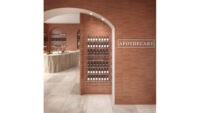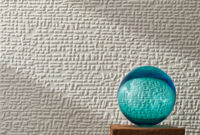North America. "Given the state of the construction industry and the economy, architects, designers and project specifiers are now looking for a practical, turnkey solution to promote new projects that are aesthetically beautiful, technologically advanced and eco-conscious," said Hector Narvaez, Executive Vice President of Sales and Marketing for Marazzi USA.
The ventilated facade is a system that incorporates an insulating layer anchored to the supporting structure, and a layer of cladding connected to a building with another anchoring system. An air space created between the insulation and the cladding creates natural ventilation. Compared with other cladding techniques where materials are applied directly to a wall structure, ventilated walls offer advantages:
• Energy savings
• Elimination of thermal bridges and surface condensation
• Ease of installation
• Easy maintenance—individual pieces can be repaired without affecting the entire exterior surface
Ventilated wall systems work in both new construction and renovations to existing buildings. These systems make it easy to do a makeover since there is no need to remove any existing surface products.
Large-format porcelain offers supreme technical and aesthetic performance; it resists freeze-thaw, fading, graffiti, abrasion and a myriad of weather conditions. Ventilated walls help absorb outside noise -- lowering the level by 10 to 15 decibels, reports Marazzi USA, adding that this sound deadening contributes to a healthier and safer work environment.
Three parts compose this ventilated wall: a cladding layer of large-format porcelain with open joints, an aluminum substructure secured by brackets that are connected to the building, and a thermal layer (comprised of weatherproof insulation) that is fastened to the building's wall. The ventilated wall system's insulation provides thermal protection, while the porcelain also stops direct sun penetration. Together, the two parts help to equalize temperature distributions and improve the energy efficiency of a building -- by up to one-third, according to the manufacturer.
The system is not just for exteriors -- it can be specified for interiors of large commercial spaces such as malls, hotels and convention centers to create a cohesive indoor-outdoor design plan. "This ventilated wall system can be customized for any project," said Narvaez. "Our project line can meet any design aesthetic -- natural, textured, contemporary, monochromatic."
According to Marazzi USA, installation is easy. First, anchor brackets are affixed to four points on the back of each tile. Second, installers attach a grid of vertical risers and horizontal runners to the exterior of the building. Third, a layer of rigid fiberglass insulation is applied. A fiber scrim covering the exposed face prevents mechanical erosion due to airflow. Fourth, the cladding is installed.
Marazzi has a team of engineers on hand to help customers with the planning and installation process. "Our Italian engineering team can get involved in the process at any stage of the project, and we have the ability to take some of the burden off the architect or designer," said Narvaez. "Our engineers can create CAD drawings early in the project, they can help to specify the perfect product for each situation, or they can provide installers with simple, cost-effective assistance for installation."
Considering both performance and aesthetics, the ventilated wall system shows that there has never been a better time to look at porcelain tile. It can be a design-savvy solution for a variety of projects of any size, scope or locale, reports the manufacturer.



